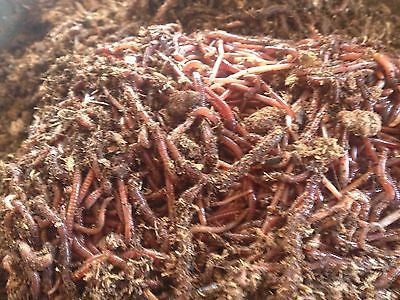Purchase Red Wiggler Worms - Perfect for Composting and Horticulture
Purchase Red Wiggler Worms - Perfect for Composting and Horticulture
Blog Article
Maximizing the Advantages of Red Wiggler Worms: A Comprehensive Handbook for Home Gardeners and Urban Farmers
In the world of sustainable horticulture techniques, red wiggler worms stand as unrecognized heroes, silently transforming organic waste right into nutrient-rich castings that can work marvels for dirt health. As home garden enthusiasts and city farmers progressively look for eco-friendly and cost-efficient ways to improve their yards, the potential benefits of taking advantage of the power of red wigglers can not be overstated. From reducing kitchen area waste to growing much healthier plants, the usage of these simple animals offers a myriad of advantages. By exploring the ins and outs of just how to properly care for and make best use of the benefits of red wiggler worms, individuals can open a wide range of opportunities for enhancing the sustainability and performance of their horticulture endeavors.
Understanding Red Wiggler Worms
Red Wiggler worms, renowned for their effective composting capabilities, are a varieties of earthworms widely used in vermiculture techniques. These worms, scientifically understood as Eisenia fetida, flourish in decomposing organic material, making them suitable prospects for composting.
One trick quality of Red Wiggler worms is their reproductive rate. These hermaphroditic animals possess both female and male reproductive body organs, enabling them to duplicate rapidly under favorable conditions. A mature Red Wiggler can generate numerous spawn in a brief duration, making sure a consistent populace within a composting system.

Establishing Up a Worm Bin
When establishing a worm bin for vermiculture objectives, proper preparation and interest to information are crucial for creating a conducive environment for Red Wiggler worms. Begin by choosing an appropriate container for your worm container.

Area the worm bin in a trendy, dark place away from straight sunlight and severe temperatures. By adhering to these steps, you can set up a growing worm bin that will successfully process natural waste into nutrient-rich vermicompost for your garden.
Feeding and Preserving Worms
Making sure a balanced and healthy diet plan is vital for the wellness and productivity of Red Wiggler worms in a vermiculture system. It is crucial to stay clear of feeding them citrus fruits, onions, garlic, dairy products, meat, and oily foods as these can be damaging to the worms or create undesirable odors in the bin.
Correct dampness degrees are also crucial for the well-being of Red Wiggler worms. By vigilantly monitoring their diet, moisture, and ecological conditions, home gardeners and city farmers can maintain a efficient and healthy and balanced Red Wiggler worm population for composting functions.
Gathering Worm Spreadings
To successfully extract nutrient-rich worm castings from the vermicompost, an organized harvesting process is necessary for taking full advantage of the composting advantages. The first action in collecting worm castings is to motivate the worms to move to one side of the bin.
After the spreadings have been collected, it is vital to separate any kind of staying worms from the castings to stay clear of harming them throughout storage or application. One reliable method is to develop cone-shaped piles of spreadings under bright light. Worms will instinctively move far from the light, enabling for easy splitting up and removal.
Finally, the harvested worm spreadings should be saved in an amazing, dark, and completely dry location to keep their high quality and effectiveness as a nutrient-rich soil change. By following these actions, home gardeners use this link and metropolitan farmers can optimize the benefits of red wiggler worms in their vermicomposting systems.
Making Use Of Worm Castings in Gardening
The unification of nutrient-rich worm spreadings into garden dirt can considerably boost plant development and overall soil health and wellness. Worm spreadings, also understood as vermicast, are an all-natural plant food generated by red wiggler worms as they damage down natural issue. These spreadings are rich in necessary nutrients like nitrogen, phosphorus, potassium, and beneficial microorganisms that promote plant growth and enhance dirt framework.
When using worm spreadings in horticulture, it is necessary to mix them completely right into the dirt or utilize them as a leading clothing around plants. The slow-release nature of worm castings makes sure a constant supply of nutrients to plants with time, minimizing the danger of nutrient leaching and advertising lasting soil fertility. Additionally, worm spreadings aid enhance soil oygenation, water retention, and microbial activity, creating a healthy and balanced setting for plant roots to thrive.

Verdict
To conclude, the application of red wiggler worms in home gardening and urban farming can dramatically profit dirt wellness and plant development. By comprehending exactly how to establish up and preserve a worm container, feed the worms appropriately, and collect their nutrient-rich spreadings, gardeners can make best use of the benefits of these earthworms. Integrating worm castings right into horticulture techniques can boost soil fertility and overall plant efficiency. Generally, red wiggler worms supply a effective and sustainable service for enhancing yard and ranch returns.
In the world of lasting horticulture techniques, red wiggler worms stand as unhonored find more info heroes, silently changing natural waste right into nutrient-rich spreadings that can function marvels for click here now soil wellness.When establishing a worm bin for vermiculture functions, appropriate preparation and interest to information are essential for producing a favorable atmosphere for Red Wiggler worms. The first step in harvesting worm castings is to encourage the worms to move to one side of the container. Worm spreadings, likewise understood as vermicast, are a natural plant food generated by red wiggler worms as they damage down natural matter. By understanding how to establish up and preserve a worm bin, feed the worms correctly, and harvest their nutrient-rich spreadings, gardeners can take full advantage of the benefits of these earthworms.
Report this page